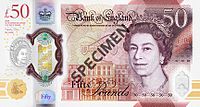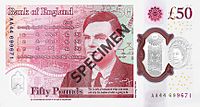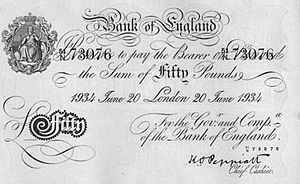Bank of England £50 note facts for kids
| (United Kingdom) | |
|---|---|
| Value | £50 sterling |
| Width | 146 mm |
| Height | 77 mm |
| Security features | See-through windows the larger one with the Queen's portrait a maroon border on both the front and back, with gold and green foil squares on the front and silver foil squares on the back, the image squares on the front changes between a '50' and a '£' symbol when the note is tilted, second smaller window at the bottom right corner, raised dots, finely detailed shaped red metallic shape containing the letters 'A' and 'T', turquoise, lilac and pink foil patch with a 3D image of the Coronation Crown, micro-lettering, textured print, UV feature, hologram |
| Paper type | Polymer |
| Years of printing | 1725–1943; 1981–1994; 1994–2011; 2011–2021; 2021–present (current design) |
| Obverse | |
 |
|
| Design | Queen Elizabeth II |
| Design date | 23 June 2021 |
| Reverse | |
 |
|
| Design | Alan Turing |
| Designer | Elliott & Fry |
| Design date | 23 June 2021 |
The Bank of England £50 note is a type of money used in the United Kingdom. It is the largest value banknote that the Bank of England currently prints for people to use. The newest £50 note is made of a special plastic material called polymer. It started being used on June 23, 2021.
This new note shows Queen Elizabeth II on the front. On the back, you will see Alan Turing, a famous computer scientist and World War II codebreaker. His birthday is the same day the new note was released. Older £50 notes, made of cotton, were used alongside the new plastic ones until September 30, 2022. After that date, the old paper notes were no longer valid.
Contents
How Did the £50 Note Change Over Time?
Early Days: Handwritten Notes (1725-1853)
The Bank of England first started making £50 notes in 1725. The very first notes were written by hand. They were given out to people as needed. These early notes only had writing on one side. They showed the person's name, the date, and the signature of the bank cashier.
For a long time, you could exchange these notes for gold at the bank. This changed between 1797 and 1821 because of wars. From 1853, printed notes took the place of handwritten ones. The phrase "I promise to pay the bearer on demand the sum of fifty pounds" appeared on them. This promise is still on Bank of England notes today.
From Paper to Polymer: Modern £50 Notes
Britain stopped exchanging banknotes for gold in 1931. The £50 note was not made between 1943 and 1981. It came back in 1981 as the "D series" note. These notes were mostly olive green. They had a picture of Queen Elizabeth II on the front. On the back was Christopher Wren, a famous architect.
These notes had a metallic thread inside them for security. This thread looked like a dashed line. But if you held it up to the light, it looked like one solid line. In 1994, the "E series" notes replaced the D series. These notes were reddish. They showed John Houblon, the first governor of the Bank of England, on the back. They also had a foil patch for extra security.
The £50 note released in 2011 was part of the "F series." It was the first Bank of England note to show two people on the back. These were engineer James Watt and businessman Matthew Boulton. This note also had a special "motion thread." This thread had a moving image that changed as you tilted the note. Other security features included raised print, a watermark, and patterns that only appeared under ultraviolet light.
The New Polymer £50 Note (Series G)
The newest £50 note, called the "Series G," came out in June 2021. It is the last Bank of England note to switch from paper to polymer plastic. The back of this note features Alan Turing. He was a brilliant mathematician and codebreaker.
The Bank of England asked for ideas for who should be on the new note. They received many suggestions for scientists. A list of famous scientists was considered. This list included people like Mary Anning, Stephen Hawking, and Alan Turing. Turing was finally chosen for the new design.
What About the Future of the £50 Note?
Some people have concerns about high-value notes like the £50. An advisor to the British Government, Peter Sands, has suggested that getting rid of these notes could help reduce financial crime. This means making it harder for people to do illegal things with money.
Different Designs of the £50 Note
Here is a quick look at the different designs of the £50 note over the years:
| Note | First issued | Last issued | Ceased to be legal tender | Colour | Size | Design | Additional information |
|---|---|---|---|---|---|---|---|
| White | 1725 | 1943 | 16 April 1945 | Monochrome (printed on one side only) | 211 × 133 mm (may vary) | ||
| Series D | 20 March 1981 | 1994 | 20 September 1996 | Predominantly olive green | 169 × 95 mm | Front: Queen Elizabeth II; Back: Christopher Wren | First £50 note to carry a portrait of a monarch and used a "windowed" security thread (July 1988 onwards) |
| Series E | 20 April 1994 | 2011 | 30 April 2014 | Predominantly red | 156 × 85 mm | Front: Queen Elizabeth II; Back: John Houblon | Foil patch for additional security |
| Series F | 2 November 2011 | 2021 | 30 September 2022 | Front: Queen Elizabeth II; Back: Matthew Boulton and James Watt | |||
| Series G (polymer) | 23 June 2021 | 146 × 77 mm | Front: Queen Elizabeth II; Back: Alan Turing | Final Series G Polymer issued note |
See also


